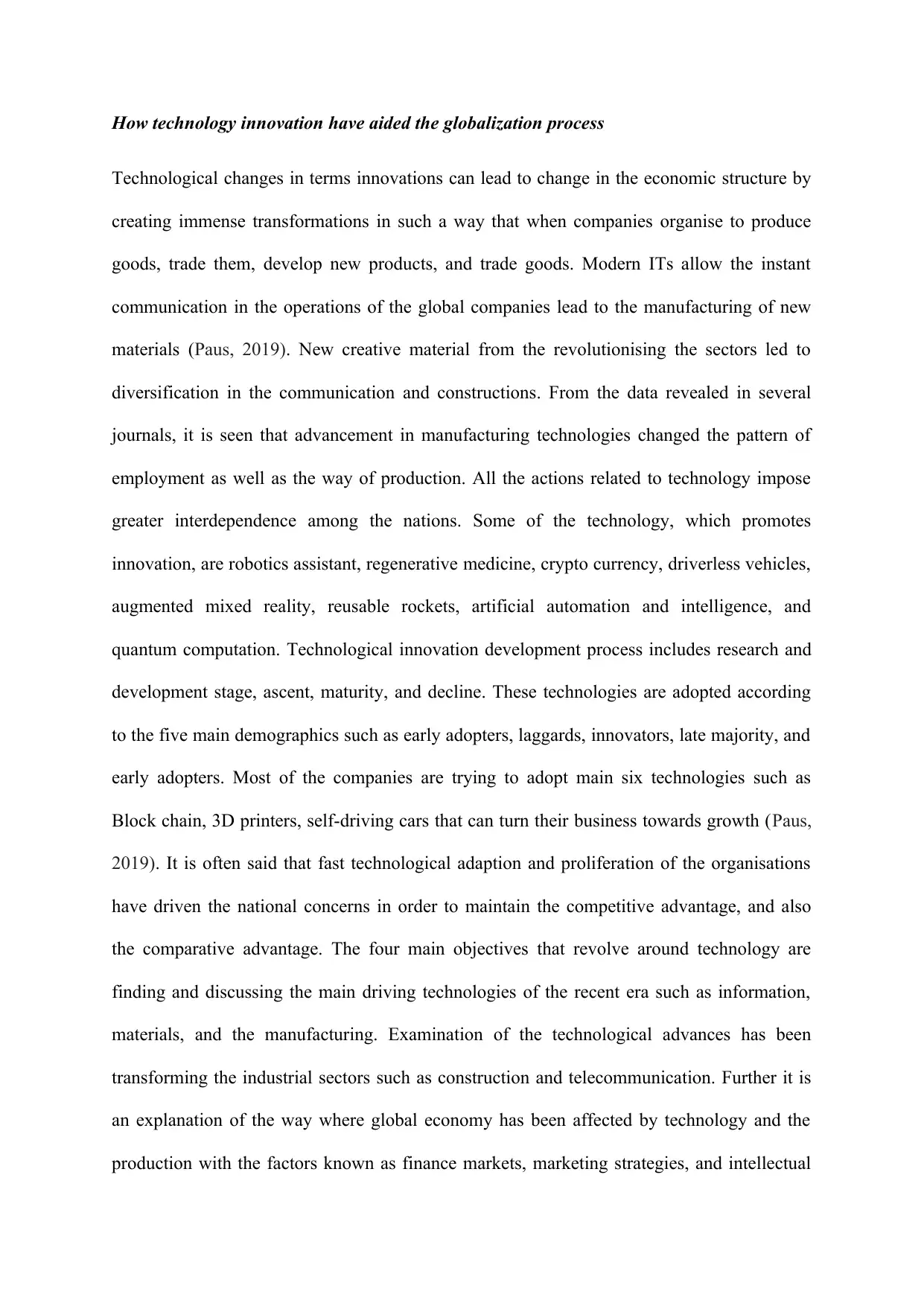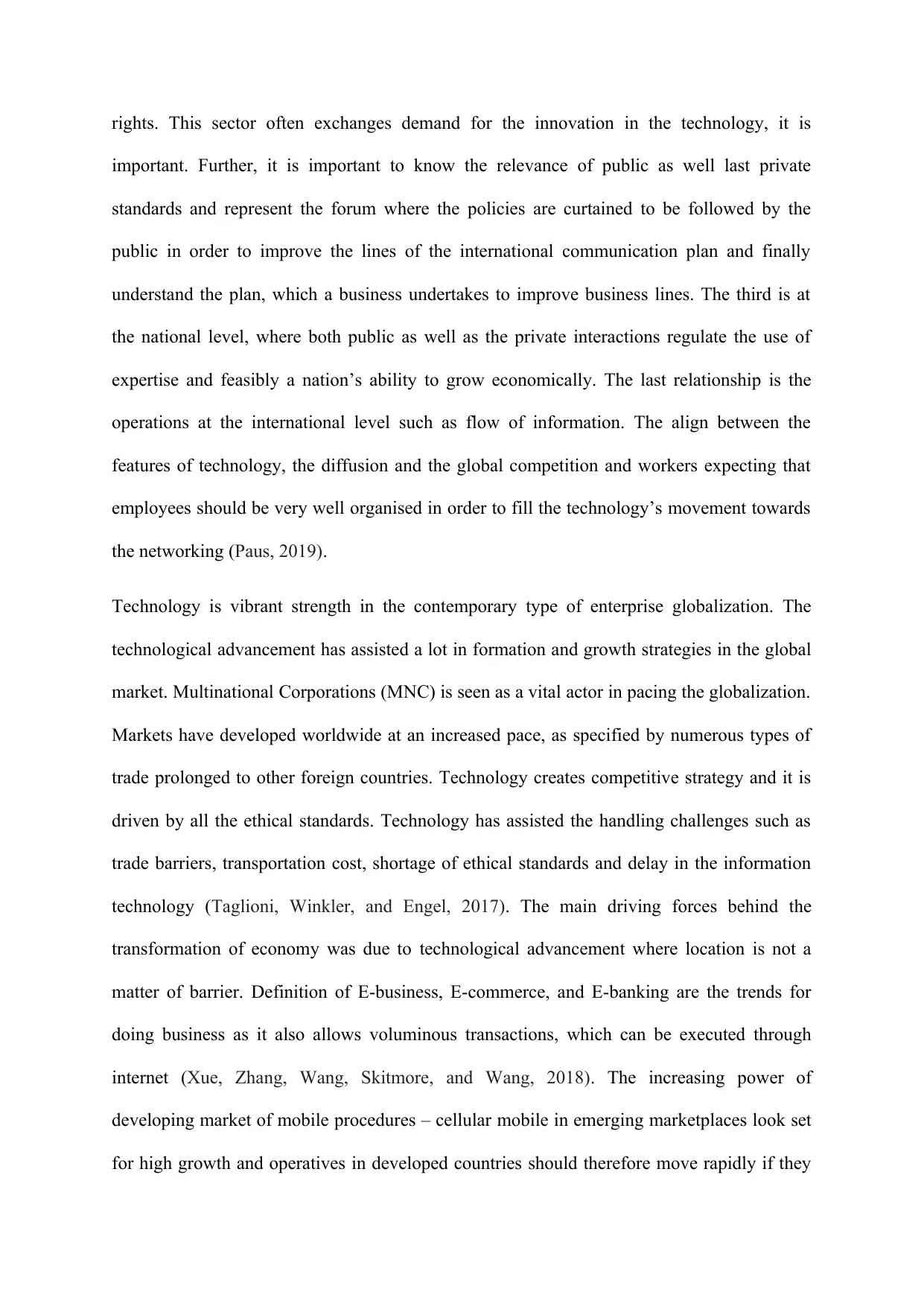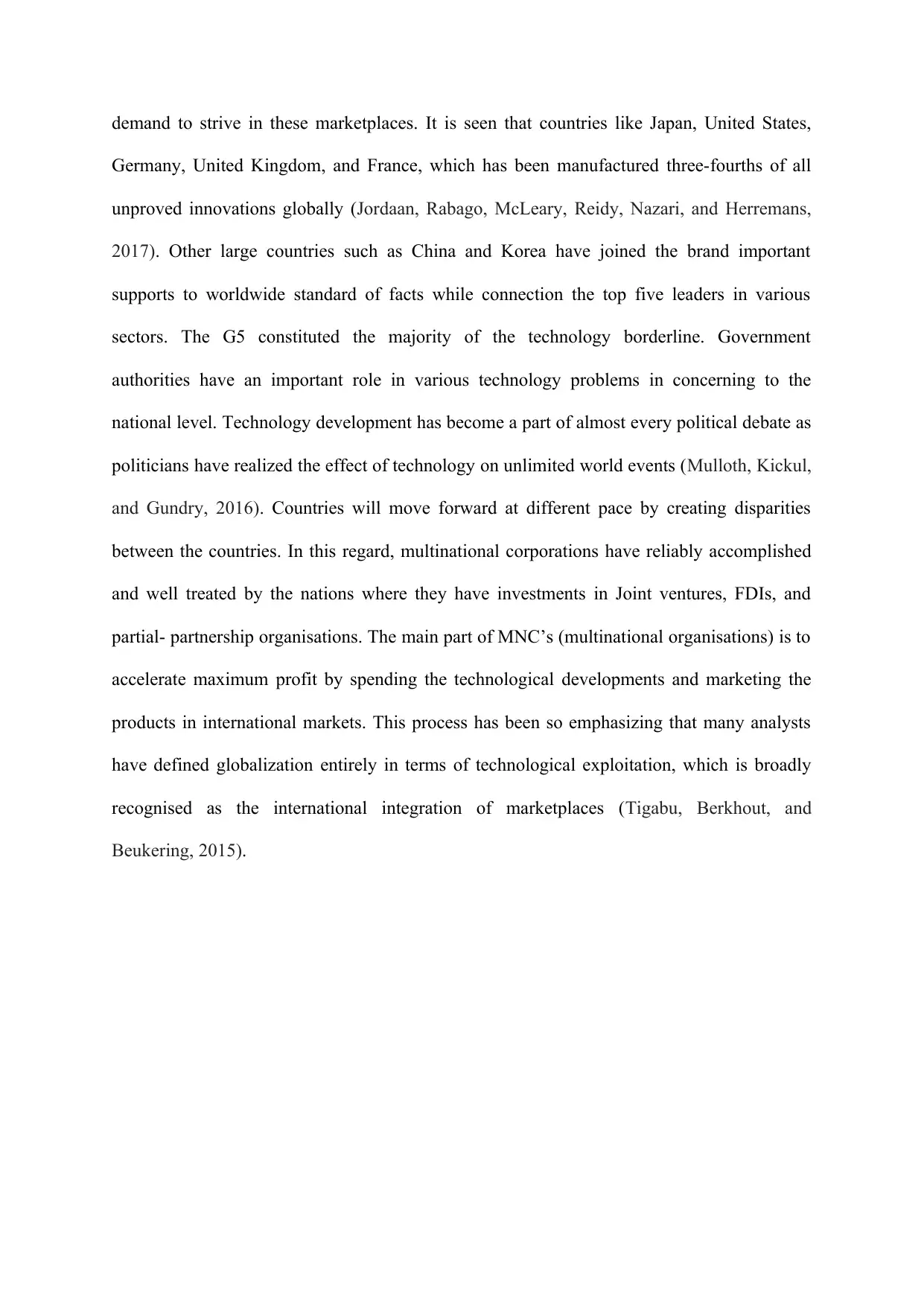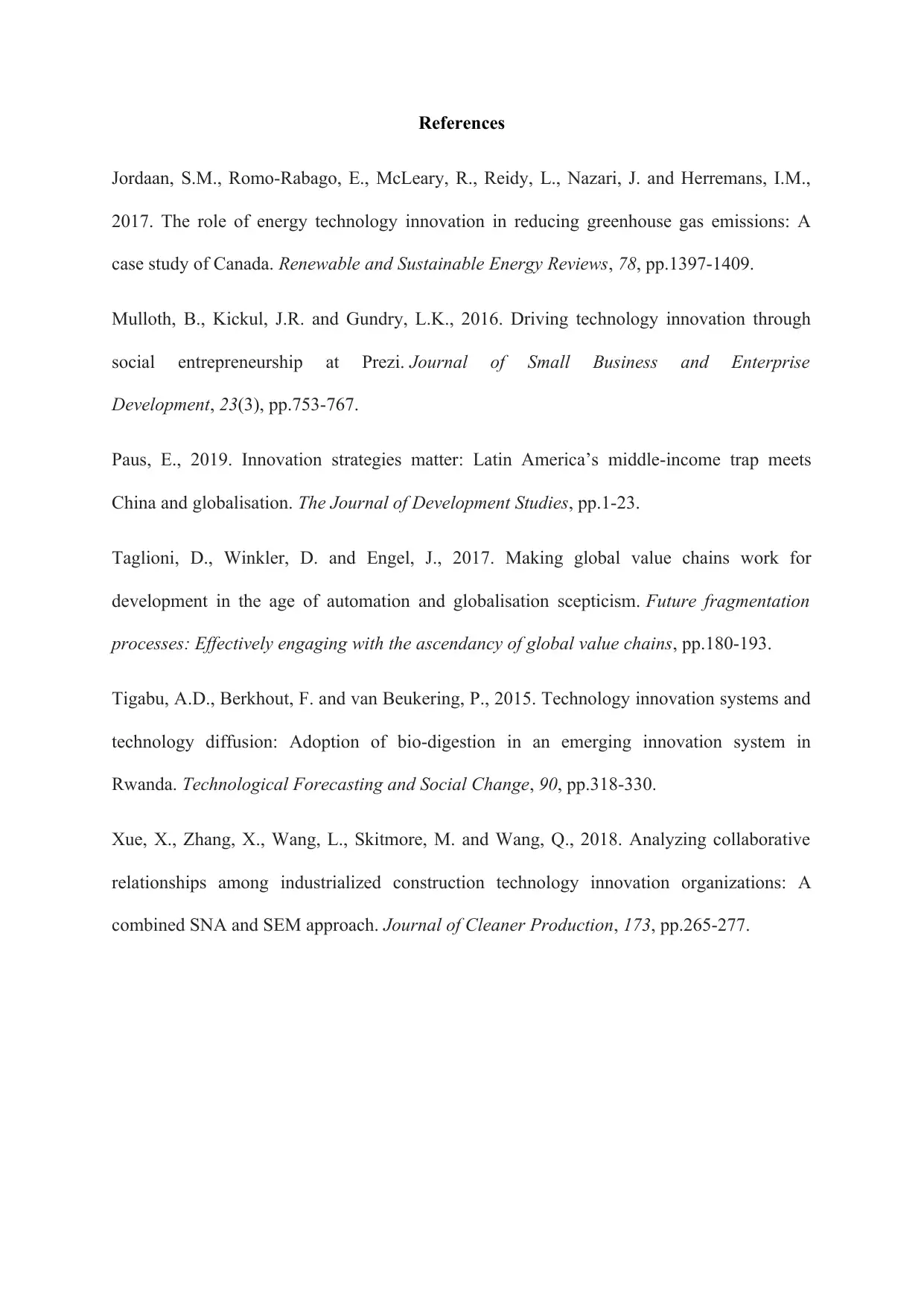Globalization and Technology: An IT Report on Innovation's Role
VerifiedAdded on 2023/03/23
|5
|1254
|54
Report
AI Summary
This IT write-up explores the significant role of technological innovations in driving the globalization process. It examines how advancements in information technology, manufacturing, and communication have reshaped economic structures, facilitating instant communication, new product development, and trade. The report discusses various technologies like robotics, AI, and blockchain, highlighting their impact on industries such as construction and telecommunication. It analyzes the effects of technology on finance markets, marketing strategies, and intellectual property rights, emphasizing the importance of public and private standards. The write-up also covers the role of multinational corporations in accelerating globalization through technological advancements, e-business, and e-commerce. Furthermore, it addresses the influence of government policies and the disparities between countries, illustrating how technology has become a crucial factor in national and international economic dynamics, with references to key academic sources.

IT WRITE-UP
Paraphrase This Document
Need a fresh take? Get an instant paraphrase of this document with our AI Paraphraser

How technology innovation have aided the globalization process
Technological changes in terms innovations can lead to change in the economic structure by
creating immense transformations in such a way that when companies organise to produce
goods, trade them, develop new products, and trade goods. Modern ITs allow the instant
communication in the operations of the global companies lead to the manufacturing of new
materials (Paus, 2019). New creative material from the revolutionising the sectors led to
diversification in the communication and constructions. From the data revealed in several
journals, it is seen that advancement in manufacturing technologies changed the pattern of
employment as well as the way of production. All the actions related to technology impose
greater interdependence among the nations. Some of the technology, which promotes
innovation, are robotics assistant, regenerative medicine, crypto currency, driverless vehicles,
augmented mixed reality, reusable rockets, artificial automation and intelligence, and
quantum computation. Technological innovation development process includes research and
development stage, ascent, maturity, and decline. These technologies are adopted according
to the five main demographics such as early adopters, laggards, innovators, late majority, and
early adopters. Most of the companies are trying to adopt main six technologies such as
Block chain, 3D printers, self-driving cars that can turn their business towards growth (Paus,
2019). It is often said that fast technological adaption and proliferation of the organisations
have driven the national concerns in order to maintain the competitive advantage, and also
the comparative advantage. The four main objectives that revolve around technology are
finding and discussing the main driving technologies of the recent era such as information,
materials, and the manufacturing. Examination of the technological advances has been
transforming the industrial sectors such as construction and telecommunication. Further it is
an explanation of the way where global economy has been affected by technology and the
production with the factors known as finance markets, marketing strategies, and intellectual
Technological changes in terms innovations can lead to change in the economic structure by
creating immense transformations in such a way that when companies organise to produce
goods, trade them, develop new products, and trade goods. Modern ITs allow the instant
communication in the operations of the global companies lead to the manufacturing of new
materials (Paus, 2019). New creative material from the revolutionising the sectors led to
diversification in the communication and constructions. From the data revealed in several
journals, it is seen that advancement in manufacturing technologies changed the pattern of
employment as well as the way of production. All the actions related to technology impose
greater interdependence among the nations. Some of the technology, which promotes
innovation, are robotics assistant, regenerative medicine, crypto currency, driverless vehicles,
augmented mixed reality, reusable rockets, artificial automation and intelligence, and
quantum computation. Technological innovation development process includes research and
development stage, ascent, maturity, and decline. These technologies are adopted according
to the five main demographics such as early adopters, laggards, innovators, late majority, and
early adopters. Most of the companies are trying to adopt main six technologies such as
Block chain, 3D printers, self-driving cars that can turn their business towards growth (Paus,
2019). It is often said that fast technological adaption and proliferation of the organisations
have driven the national concerns in order to maintain the competitive advantage, and also
the comparative advantage. The four main objectives that revolve around technology are
finding and discussing the main driving technologies of the recent era such as information,
materials, and the manufacturing. Examination of the technological advances has been
transforming the industrial sectors such as construction and telecommunication. Further it is
an explanation of the way where global economy has been affected by technology and the
production with the factors known as finance markets, marketing strategies, and intellectual

rights. This sector often exchanges demand for the innovation in the technology, it is
important. Further, it is important to know the relevance of public as well last private
standards and represent the forum where the policies are curtained to be followed by the
public in order to improve the lines of the international communication plan and finally
understand the plan, which a business undertakes to improve business lines. The third is at
the national level, where both public as well as the private interactions regulate the use of
expertise and feasibly a nation’s ability to grow economically. The last relationship is the
operations at the international level such as flow of information. The align between the
features of technology, the diffusion and the global competition and workers expecting that
employees should be very well organised in order to fill the technology’s movement towards
the networking (Paus, 2019).
Technology is vibrant strength in the contemporary type of enterprise globalization. The
technological advancement has assisted a lot in formation and growth strategies in the global
market. Multinational Corporations (MNC) is seen as a vital actor in pacing the globalization.
Markets have developed worldwide at an increased pace, as specified by numerous types of
trade prolonged to other foreign countries. Technology creates competitive strategy and it is
driven by all the ethical standards. Technology has assisted the handling challenges such as
trade barriers, transportation cost, shortage of ethical standards and delay in the information
technology (Taglioni, Winkler, and Engel, 2017). The main driving forces behind the
transformation of economy was due to technological advancement where location is not a
matter of barrier. Definition of E-business, E-commerce, and E-banking are the trends for
doing business as it also allows voluminous transactions, which can be executed through
internet (Xue, Zhang, Wang, Skitmore, and Wang, 2018). The increasing power of
developing market of mobile procedures – cellular mobile in emerging marketplaces look set
for high growth and operatives in developed countries should therefore move rapidly if they
important. Further, it is important to know the relevance of public as well last private
standards and represent the forum where the policies are curtained to be followed by the
public in order to improve the lines of the international communication plan and finally
understand the plan, which a business undertakes to improve business lines. The third is at
the national level, where both public as well as the private interactions regulate the use of
expertise and feasibly a nation’s ability to grow economically. The last relationship is the
operations at the international level such as flow of information. The align between the
features of technology, the diffusion and the global competition and workers expecting that
employees should be very well organised in order to fill the technology’s movement towards
the networking (Paus, 2019).
Technology is vibrant strength in the contemporary type of enterprise globalization. The
technological advancement has assisted a lot in formation and growth strategies in the global
market. Multinational Corporations (MNC) is seen as a vital actor in pacing the globalization.
Markets have developed worldwide at an increased pace, as specified by numerous types of
trade prolonged to other foreign countries. Technology creates competitive strategy and it is
driven by all the ethical standards. Technology has assisted the handling challenges such as
trade barriers, transportation cost, shortage of ethical standards and delay in the information
technology (Taglioni, Winkler, and Engel, 2017). The main driving forces behind the
transformation of economy was due to technological advancement where location is not a
matter of barrier. Definition of E-business, E-commerce, and E-banking are the trends for
doing business as it also allows voluminous transactions, which can be executed through
internet (Xue, Zhang, Wang, Skitmore, and Wang, 2018). The increasing power of
developing market of mobile procedures – cellular mobile in emerging marketplaces look set
for high growth and operatives in developed countries should therefore move rapidly if they
⊘ This is a preview!⊘
Do you want full access?
Subscribe today to unlock all pages.

Trusted by 1+ million students worldwide

demand to strive in these marketplaces. It is seen that countries like Japan, United States,
Germany, United Kingdom, and France, which has been manufactured three-fourths of all
unproved innovations globally (Jordaan, Rabago, McLeary, Reidy, Nazari, and Herremans,
2017). Other large countries such as China and Korea have joined the brand important
supports to worldwide standard of facts while connection the top five leaders in various
sectors. The G5 constituted the majority of the technology borderline. Government
authorities have an important role in various technology problems in concerning to the
national level. Technology development has become a part of almost every political debate as
politicians have realized the effect of technology on unlimited world events (Mulloth, Kickul,
and Gundry, 2016). Countries will move forward at different pace by creating disparities
between the countries. In this regard, multinational corporations have reliably accomplished
and well treated by the nations where they have investments in Joint ventures, FDIs, and
partial- partnership organisations. The main part of MNC’s (multinational organisations) is to
accelerate maximum profit by spending the technological developments and marketing the
products in international markets. This process has been so emphasizing that many analysts
have defined globalization entirely in terms of technological exploitation, which is broadly
recognised as the international integration of marketplaces (Tigabu, Berkhout, and
Beukering, 2015).
Germany, United Kingdom, and France, which has been manufactured three-fourths of all
unproved innovations globally (Jordaan, Rabago, McLeary, Reidy, Nazari, and Herremans,
2017). Other large countries such as China and Korea have joined the brand important
supports to worldwide standard of facts while connection the top five leaders in various
sectors. The G5 constituted the majority of the technology borderline. Government
authorities have an important role in various technology problems in concerning to the
national level. Technology development has become a part of almost every political debate as
politicians have realized the effect of technology on unlimited world events (Mulloth, Kickul,
and Gundry, 2016). Countries will move forward at different pace by creating disparities
between the countries. In this regard, multinational corporations have reliably accomplished
and well treated by the nations where they have investments in Joint ventures, FDIs, and
partial- partnership organisations. The main part of MNC’s (multinational organisations) is to
accelerate maximum profit by spending the technological developments and marketing the
products in international markets. This process has been so emphasizing that many analysts
have defined globalization entirely in terms of technological exploitation, which is broadly
recognised as the international integration of marketplaces (Tigabu, Berkhout, and
Beukering, 2015).
Paraphrase This Document
Need a fresh take? Get an instant paraphrase of this document with our AI Paraphraser

References
Jordaan, S.M., Romo-Rabago, E., McLeary, R., Reidy, L., Nazari, J. and Herremans, I.M.,
2017. The role of energy technology innovation in reducing greenhouse gas emissions: A
case study of Canada. Renewable and Sustainable Energy Reviews, 78, pp.1397-1409.
Mulloth, B., Kickul, J.R. and Gundry, L.K., 2016. Driving technology innovation through
social entrepreneurship at Prezi. Journal of Small Business and Enterprise
Development, 23(3), pp.753-767.
Paus, E., 2019. Innovation strategies matter: Latin America’s middle-income trap meets
China and globalisation. The Journal of Development Studies, pp.1-23.
Taglioni, D., Winkler, D. and Engel, J., 2017. Making global value chains work for
development in the age of automation and globalisation scepticism. Future fragmentation
processes: Effectively engaging with the ascendancy of global value chains, pp.180-193.
Tigabu, A.D., Berkhout, F. and van Beukering, P., 2015. Technology innovation systems and
technology diffusion: Adoption of bio-digestion in an emerging innovation system in
Rwanda. Technological Forecasting and Social Change, 90, pp.318-330.
Xue, X., Zhang, X., Wang, L., Skitmore, M. and Wang, Q., 2018. Analyzing collaborative
relationships among industrialized construction technology innovation organizations: A
combined SNA and SEM approach. Journal of Cleaner Production, 173, pp.265-277.
Jordaan, S.M., Romo-Rabago, E., McLeary, R., Reidy, L., Nazari, J. and Herremans, I.M.,
2017. The role of energy technology innovation in reducing greenhouse gas emissions: A
case study of Canada. Renewable and Sustainable Energy Reviews, 78, pp.1397-1409.
Mulloth, B., Kickul, J.R. and Gundry, L.K., 2016. Driving technology innovation through
social entrepreneurship at Prezi. Journal of Small Business and Enterprise
Development, 23(3), pp.753-767.
Paus, E., 2019. Innovation strategies matter: Latin America’s middle-income trap meets
China and globalisation. The Journal of Development Studies, pp.1-23.
Taglioni, D., Winkler, D. and Engel, J., 2017. Making global value chains work for
development in the age of automation and globalisation scepticism. Future fragmentation
processes: Effectively engaging with the ascendancy of global value chains, pp.180-193.
Tigabu, A.D., Berkhout, F. and van Beukering, P., 2015. Technology innovation systems and
technology diffusion: Adoption of bio-digestion in an emerging innovation system in
Rwanda. Technological Forecasting and Social Change, 90, pp.318-330.
Xue, X., Zhang, X., Wang, L., Skitmore, M. and Wang, Q., 2018. Analyzing collaborative
relationships among industrialized construction technology innovation organizations: A
combined SNA and SEM approach. Journal of Cleaner Production, 173, pp.265-277.
1 out of 5
Related Documents
Your All-in-One AI-Powered Toolkit for Academic Success.
+13062052269
info@desklib.com
Available 24*7 on WhatsApp / Email
![[object Object]](/_next/static/media/star-bottom.7253800d.svg)
Unlock your academic potential
Copyright © 2020–2025 A2Z Services. All Rights Reserved. Developed and managed by ZUCOL.





